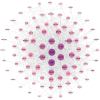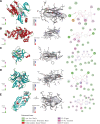Therapeutic mechanism and key active ingredients of Yinxing Mihuan Oral Solution in coronary heart disease comorbidity with anxiety: A network pharmacology and molecular docking approach
- PMID: 39470548
- PMCID: PMC11521018
- DOI: 10.1097/MD.0000000000040183
Therapeutic mechanism and key active ingredients of Yinxing Mihuan Oral Solution in coronary heart disease comorbidity with anxiety: A network pharmacology and molecular docking approach
Abstract
Yinxing Mihuan Oral Solution (YMOS) is a Chinese patent medicine for treating coronary heart disease combined anxiety (CHDCA), but the molecular mechanism of its treatment is still unclear. This article aims to understand the molecular mechanism, optimize clinical drug use, and guide new drug development. Using the Swiss Target Prediction database, we obtained the main chemical composition of YMOS. Then we used network pharmacology to identify their potential targets. Network construction, coupled with protein-protein interaction and enrichment analysis was used to identify representative components and core targets. Finally, molecular docking simulation was conducted to further refine the drug-target interaction. Forty-two active chemicals were found in YMOS and 91 target genes related to CHDCA. The treatment effect was found to be associated with 1908 biological processes and 160 pathways, as revealed by the outcomes of the enrichment analysis. The potential therapeutic mechanisms of the drug are closely related to its antioxidant, anti-inflammatory, and vascular function regulation pathways, and the main core targets include albumin, tumor necrosis factor, TP53, AKT serine/threonine kinase 1, interleukin 1 beta, and vascular endothelial growth factor A. The potential molecular mechanisms of YMOS in CHDCA treatment were identified using network pharmacology and molecular docking approaches. The results reveal the systemic biological implications of YMOS. This study has systematically uncovered the molecular mechanism of YMOS for the first time, offering fresh insights for evidence-based clinical applications.
Copyright © 2024 the Author(s). Published by Wolters Kluwer Health, Inc.
Conflict of interest statement
The authors have no conflicts of interest to disclose.
Figures







Similar articles
-
Exploring active ingredients and mechanisms of Coptidis Rhizoma-ginger against colon cancer using network pharmacology and molecular docking.Technol Health Care. 2024;32(S1):523-542. doi: 10.3233/THC-248046. Technol Health Care. 2024. PMID: 38759074 Free PMC article.
-
Using ultra-performance liquid chromatography with linear ion trap-electrostatic field orbitrap mass spectrometry, network pharmacology, and molecular docking to explore the constituent targets and action mechanisms of decoction of Angelica sinensis, Zingiberis Rhizoma Recens, and Mutton in the treatment of diarrhea-predominant irritable bowel syndrome.J Pharm Pharmacol. 2024 May 3;76(5):462-478. doi: 10.1093/jpp/rgad076. J Pharm Pharmacol. 2024. PMID: 37832514
-
Exploring the pharmacological components and effective mechanism of Mori Folium against periodontitis using network pharmacology and molecular docking.Arch Oral Biol. 2022 Jul;139:105391. doi: 10.1016/j.archoralbio.2022.105391. Epub 2022 Mar 21. Arch Oral Biol. 2022. PMID: 35430443
-
Research on the Regulatory Mechanism of Ginseng on the Tumor Microenvironment of Colorectal Cancer based on Network Pharmacology and Bioinformatics Validation.Curr Comput Aided Drug Des. 2024;20(5):486-500. doi: 10.2174/1573409919666230607103721. Curr Comput Aided Drug Des. 2024. PMID: 37287284
-
Exploring the mechanism of action of Yiyi Fuzi Baijiang powder in colorectal cancer based on network pharmacology and molecular docking studies.Biotechnol Genet Eng Rev. 2023 Oct;39(2):1107-1127. doi: 10.1080/02648725.2023.2167765. Epub 2023 Feb 3. Biotechnol Genet Eng Rev. 2023. PMID: 36735641 Review.
References
-
- Zablotsky B, Weeks JD, Terlizzi EP, Madans JH, Blumberg SJ. Assessing anxiety and depression: a comparison of national health interview survey measures. Natl Health Stat Report. 2022;172:1–17. - PubMed
MeSH terms
Substances
LinkOut - more resources
Full Text Sources
Research Materials
Miscellaneous

